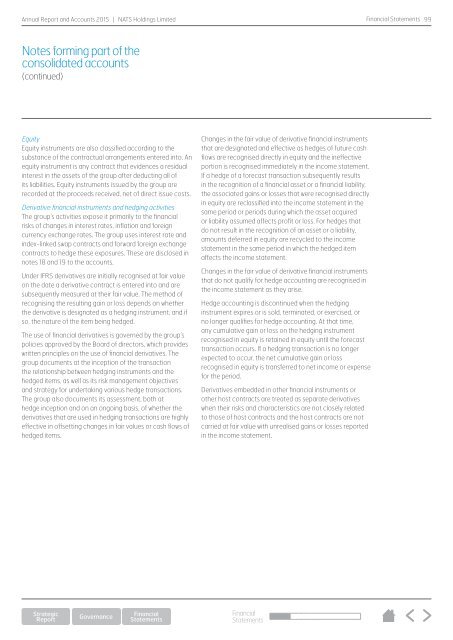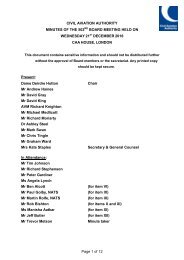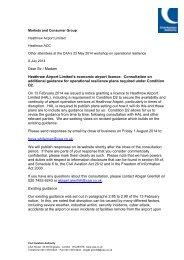NATS-Annual-Report-2015
NATS-Annual-Report-2015
NATS-Annual-Report-2015
You also want an ePaper? Increase the reach of your titles
YUMPU automatically turns print PDFs into web optimized ePapers that Google loves.
<strong>Annual</strong> <strong>Report</strong> and Accounts <strong>2015</strong> | <strong>NATS</strong> Holdings Limited<br />
Financial Statements 99<br />
Notes forming part of the<br />
consolidated accounts<br />
(continued)<br />
Equity<br />
Equity instruments are also classified according to the<br />
substance of the contractual arrangements entered into. An<br />
equity instrument is any contract that evidences a residual<br />
interest in the assets of the group after deducting all of<br />
its liabilities. Equity instruments issued by the group are<br />
recorded at the proceeds received, net of direct issue costs.<br />
Derivative financial instruments and hedging activities<br />
The group’s activities expose it primarily to the financial<br />
risks of changes in interest rates, inflation and foreign<br />
currency exchange rates. The group uses interest rate and<br />
index-linked swap contracts and forward foreign exchange<br />
contracts to hedge these exposures. These are disclosed in<br />
notes 18 and 19 to the accounts.<br />
Under IFRS derivatives are initially recognised at fair value<br />
on the date a derivative contract is entered into and are<br />
subsequently measured at their fair value. The method of<br />
recognising the resulting gain or loss depends on whether<br />
the derivative is designated as a hedging instrument, and if<br />
so, the nature of the item being hedged.<br />
The use of financial derivatives is governed by the group’s<br />
policies approved by the Board of directors, which provides<br />
written principles on the use of financial derivatives. The<br />
group documents at the inception of the transaction<br />
the relationship between hedging instruments and the<br />
hedged items, as well as its risk management objectives<br />
and strategy for undertaking various hedge transactions.<br />
The group also documents its assessment, both at<br />
hedge inception and on an ongoing basis, of whether the<br />
derivatives that are used in hedging transactions are highly<br />
effective in offsetting changes in fair values or cash flows of<br />
hedged items.<br />
Changes in the fair value of derivative financial instruments<br />
that are designated and effective as hedges of future cash<br />
flows are recognised directly in equity and the ineffective<br />
portion is recognised immediately in the income statement.<br />
If a hedge of a forecast transaction subsequently results<br />
in the recognition of a financial asset or a financial liability,<br />
the associated gains or losses that were recognised directly<br />
in equity are reclassified into the income statement in the<br />
same period or periods during which the asset acquired<br />
or liability assumed affects profit or loss. For hedges that<br />
do not result in the recognition of an asset or a liability,<br />
amounts deferred in equity are recycled to the income<br />
statement in the same period in which the hedged item<br />
affects the income statement.<br />
Changes in the fair value of derivative financial instruments<br />
that do not qualify for hedge accounting are recognised in<br />
the income statement as they arise.<br />
Hedge accounting is discontinued when the hedging<br />
instrument expires or is sold, terminated, or exercised, or<br />
no longer qualifies for hedge accounting. At that time,<br />
any cumulative gain or loss on the hedging instrument<br />
recognised in equity is retained in equity until the forecast<br />
transaction occurs. If a hedging transaction is no longer<br />
expected to occur, the net cumulative gain or loss<br />
recognised in equity is transferred to net income or expense<br />
for the period.<br />
Derivatives embedded in other financial instruments or<br />
other host contracts are treated as separate derivatives<br />
when their risks and characteristics are not closely related<br />
to those of host contracts and the host contracts are not<br />
carried at fair value with unrealised gains or losses reported<br />
in the income statement.<br />
Financial<br />
Statements






